When Did Giotto Di Bondone Make His First Art Piece
Westwardho was Giotto di Bondone? Giotto the artist is regarded as among the most influential artists in the history of Western art. Giotto di Bondone'due south art introduced a new historic period in the arts that combined spiritual antiquity with the nascent notion of Renaissance Humanism, predating by a hundred years many of the fascinations and issues of the Italian High Renaissance. Furthermore, many historians feel that the painter Giotto'southward effect on European art was unrivaled until Michelangelo assumed his role 200 years later.
Table of Contents
- i A Giotto di Bondone Biography
- i.1 The Childhood of Giotto di Bondone
- 1.2 Early Preparation and Career
- i.iii Mature Menses
- 1.4 Late Period
- two The Art Style and Legacy of Giotto di Bondone
- 2.1 Giotto'southward Nigh Influential Work
- 3 Recommended Reading
- 3.1 Giotto and His Publics (2011) by Julian Gardner
- iii.2 Giotto and His Works in Padua (2016) by John Ruskin
- 3.3 Delphi Consummate Works of Giotto (2016) by Peter Russel
- iv Oftentimes Asked Questions
- 4.1 Who Was Giotto di Bondone?
- 4.2 What Is Giotto Famous For?
A Giotto di Bondone Biography
Giotto the artist is most known for probing the potentials of perspectives and artful space, giving his religious stories a new sense of realism. Painter Giotto's concern with humanism led him to investigate the contradiction between biblical imagery and the ordinary lives of lay worshipers, with the goal of bringing people nearer to God by creating art more than appropriate to their personal experiences.
Giotto'southward Renaissance characters were therefore imbued with an emotional intensity hitherto unseen in fine art, whereas his architectural environs were represented in accordance with optical rules of perspective and proportion.
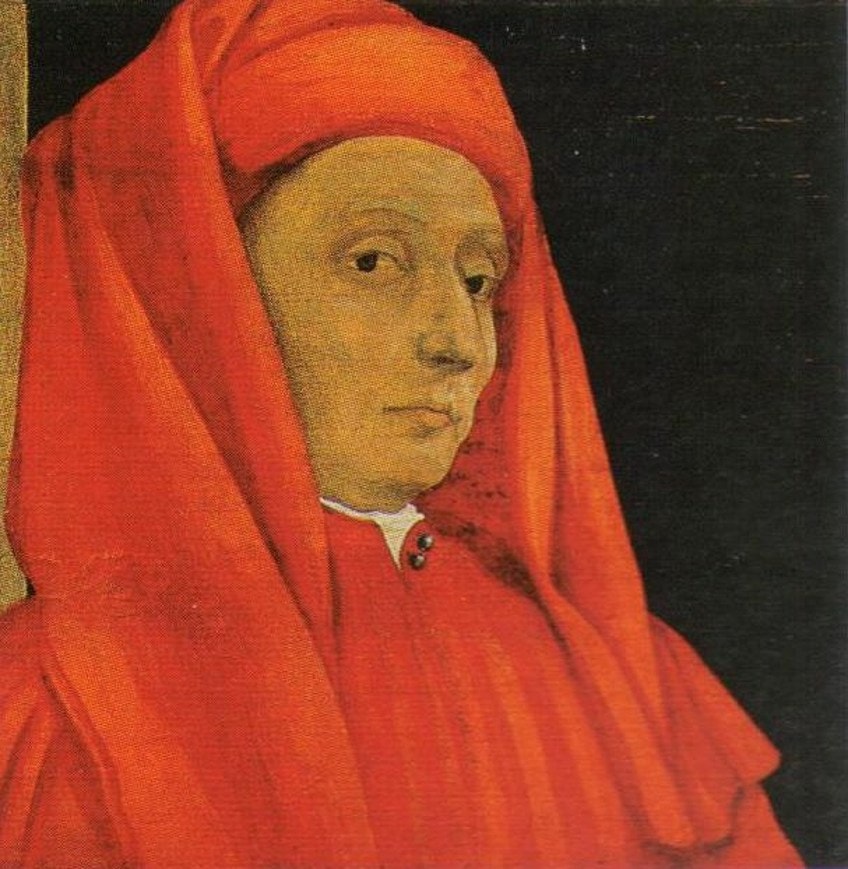 Giotto di Bondone in Five Famous Men from the Italian Renaissance (c. the 1490s) past the Florentine School; Florentine School, Public domain, via Wikimedia Eatables
Giotto di Bondone in Five Famous Men from the Italian Renaissance (c. the 1490s) past the Florentine School; Florentine School, Public domain, via Wikimedia Eatables
Giotto the artist was considered by his peers to be the near administrative virtuoso of art in his day, cartoon all of his figures and poses according to reality and his publicly acknowledged aptitude and quality. He broke with the prevailing Byzantine manner and pioneered the wonderful style of painting as we sympathize information technology today, inventing the skill of drawing precisely from reality, which had been abandoned for more than 200 years.
| Nationality | Italian |
| Date of Birth | c. 1267 |
| Appointment of Death | 8 January 1337 |
| Identify of Birth | Florence, Italy |
The Childhood of Giotto di Bondone
Giotto is said to take been raised in a farmhouse. Since 1850, a belfry business firm in side by side Colle Vespignano has carried an inscription proclaiming the stardom of his birthplace, a claim that has been widely advertised. Recent research, yet, has revealed documentary proof suggesting he was actually born in Florence, the child of a blacksmith. Bondone was the name of his begetter. He is considered to accept been the child of a farmer, originating in the Mugello, a hilly region northward of Florence that was too the homeland of the Medicis, who rose to prominence in the city.
Some historians believe he was born effectually 1277, but other sources believe he was built-in in 1267, which appears more plausible based on the sophistication of several of his early pieces.
Early Training and Career
Co-ordinate to Vasari, in his youth, Giotto di Bondone was a shepherd boy, a happy and vivid youngster who was adored by all who encountered him. Cimabue, the famous Florentine creative person, came upon Giotto sketching drawings of his flock on a rock. Cimabue chosen on Giotto and asked if he may bring him on as an assistant since they were so lifelike. Vasari tells several accounts of young painter Giotto's talent.
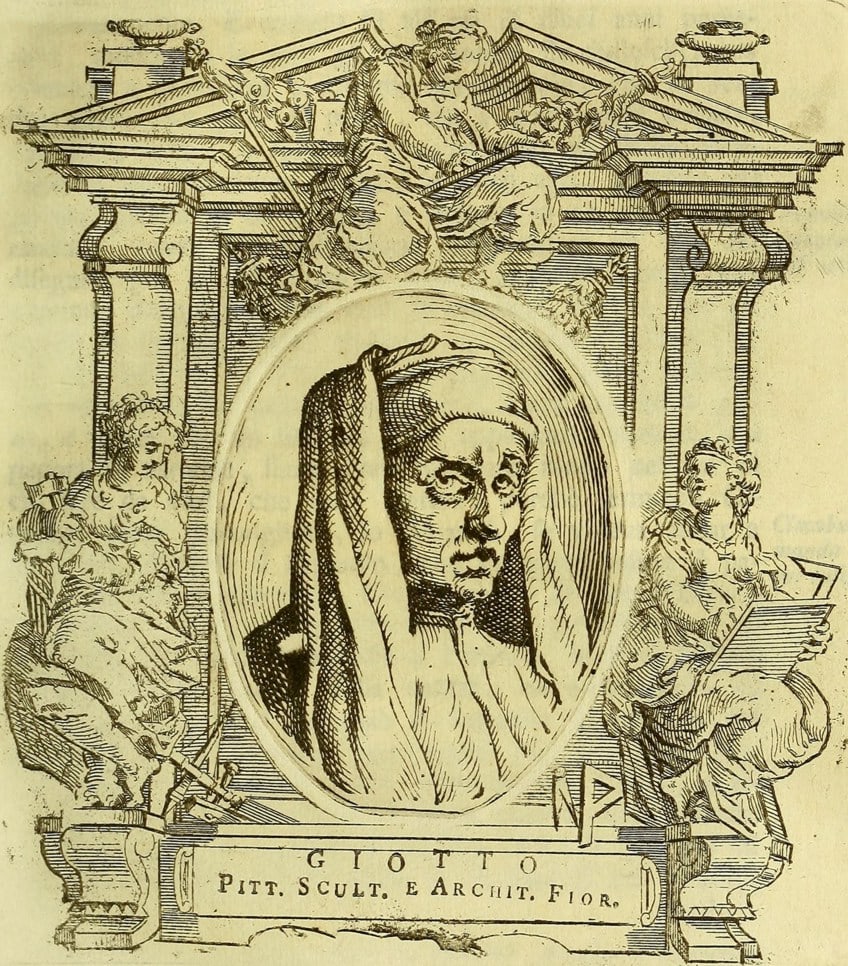 Giotto di Bondone in Giorgio Vasari's Lives of the Nearly Excellent Painters, Sculptors, and Architects (Le vite de' più eccellenti pittori, scultori e architettori) (1767); Giorgio Vasari, Public domain, via Wikimedia Commons
Giotto di Bondone in Giorgio Vasari's Lives of the Nearly Excellent Painters, Sculptors, and Architects (Le vite de' più eccellenti pittori, scultori e architettori) (1767); Giorgio Vasari, Public domain, via Wikimedia Commons
He recalls a day when Cimabue was not there at the studio and Giotto put a stunningly realistic fly on the forehead in a motion picture of Cimabue. When Cimabue arrived, he attempted to flick the fly abroad many times. Many contemporary experts are skeptical of Giotto'south instruction and regard Vasari's assertion that he was Cimabue'due south student as mythical; they cite older materials that imply Giotto the artist was not Cimabue'due south educatee.
The wing narrative is especially suspicious since information technology resembles Pliny the Elder's narrative near Zeuxis depicting grapes so realistically that birds sought to crumb at them.
Whatever the real origins of their professional connection, it is probable that Giotto was taught by Cimabue, most probable starting around the age of ten, where he caused the craft of painting. According to Vasari, when Pope Benedict Xi sent out an envoy to Giotto and asked him to produce a picture to illustrate his expertise, the painter Giotto drew a red circumvolve so flawless that it appeared to be washed with a pair of compasses and told the envoy to submit it to the Pope.
The messenger was dissatisfied and left, feeling he had just been made a consummate fool of. Along with Giotto di Bondone'due south art, the courier returned to the Pope paintings past other painters. When the messenger described how he had completed the circle without lifting his arm or using compasses, the Pope and his consorts were astounded at how Giotto'due south talent was far beyond that of his contemporaries.
Although Cimabue was Giotto's instructor, the pupil apace surpassed his principal, and his talent was best-selling during his lifetime by contemporaries such as poet Dante Alighieri, who wrote "Oh, the vain pride of human talents! Cimabue expected to retain the field, but at present Giotto has the voice, and the other's glory is lessened."
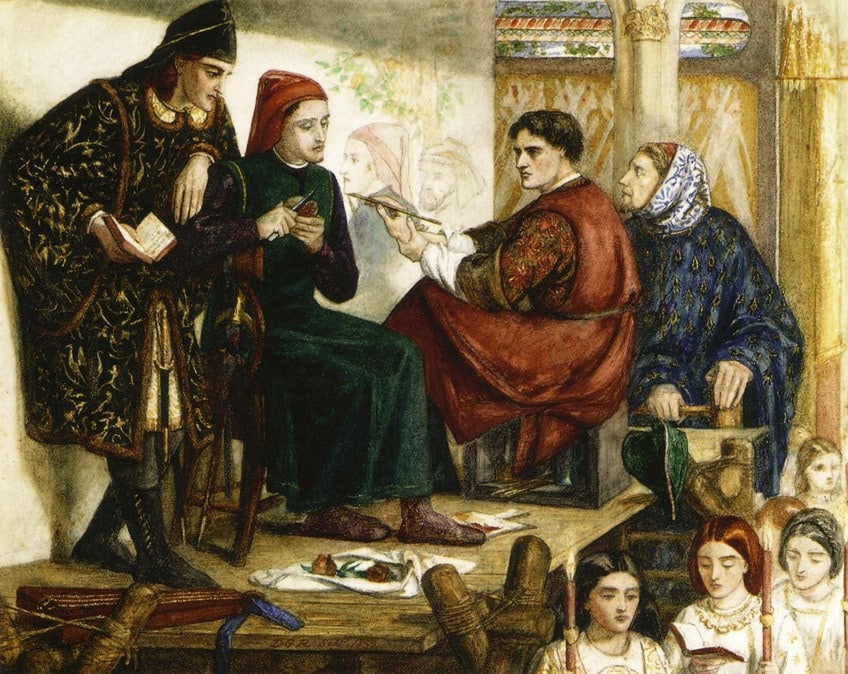 Giotto Painting the Portrait of Dante (1852) past Dante Gabriel Rossetti; Dante Gabriel Rossetti, Public domain, via Wikimedia Commons
Giotto Painting the Portrait of Dante (1852) past Dante Gabriel Rossetti; Dante Gabriel Rossetti, Public domain, via Wikimedia Commons
Giotto is said to have traveled to Rome with his instructor earlier following him to Assisi, where he had been appointed to adorn 2 churches just erected to celebrate St Francis. Although Cimabue traveled to Assisi to paint numerous big murals for the new Basilica in Assisi, it is believable, but not confirmed, that Giotto accompanied him. The provenance of the landscape cycle of St. Francis' Life in the Higher Church building has get 1 of the most contentious in art history.
Because the Franciscan Friars' documentation pertaining to creative contracts during this era were destroyed by Napoleon'southward forces, who stabled animals in the Upper Church of the Basilica, experts take contested Giotto'south attribution.
In the lack of contradictory evidence, information technology was elementary to credit any landscape in the Upper Church building that was not clearly by Cimabue to the ameliorate-known Giotto. It was also speculated that Giotto may accept executed the paintings ascribed to the Master of Isaac. Art experts investigated all of the Assisi paintings in the 1960s and discovered that role of the paint included white atomic number 82, which was also used in Cimabue'due south severely deteriorating Crucifixion (c. 1283). This medium is not used in any of Giotto'southward known works. Nevertheless, Giotto'south paintings of St. Francis' Stigmatization (near 1297) take a theme of the saint propping upwardly the crumbling church, which was previously incorporated in the Assisi murals.
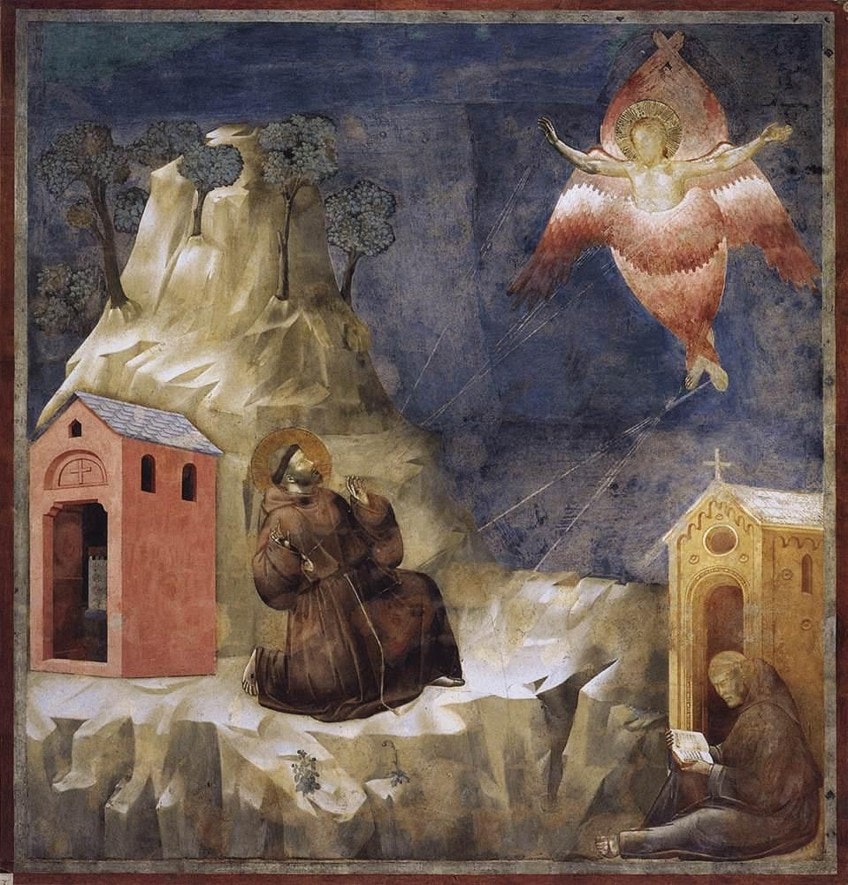 Legend of St Francis: 19. Stigmatization of St Francis (between 1297 and 1300) by Giotto di Bondone;Formerly attributed to Giotto, Public domain, via Wikimedia Eatables
Legend of St Francis: 19. Stigmatization of St Francis (between 1297 and 1300) by Giotto di Bondone;Formerly attributed to Giotto, Public domain, via Wikimedia Eatables
The attribution of several panel paintings attributed to the painter Giotto by Vasari, and some others, is as much debated as the Assisi paintings. Giotto'due south initial efforts, according to Vasari, were produced for the Dominican monks at Santa Maria Novella. They feature a mural of The Announcement and a massive hanging Crucifix that is about five meters tall.
It was completed in 1290 and is assumed to exist contemporaneous with the Assisi paintings.
Many researchers accept questioned Giotto's authorship of the Upper Church paintings. Without show, attributing claims have depended on connoisseurship, a typically untrustworthy "scientific method," but in 2002, technical investigations and analyses of the studio painting techniques at Assisi and Padua produced credible proof that Giotto the creative person did not produce the St. Francis Bike.
 Legend of St Francis: 01. Homage of a Unproblematic Human (1300) from Giotto'due south St. Francis Bicycle; Giotto, Public domain, via Wikimedia Commons
Legend of St Francis: 01. Homage of a Unproblematic Human (1300) from Giotto'due south St. Francis Bicycle; Giotto, Public domain, via Wikimedia Commons
Mature Period
Giotto wedded a Florentine lady named Ceuta in 1290, with whom he had several children. Someone reportedly asked Giotto the artist how he could make such beautiful paintings even so generate such hideous offspring, to which he answered that he produced his offspring in the dark. Giotto completed his first significant work at Assisi from 1290 to 1295, during which he achieved a number of notable graphical improvements.
Giotto di Bondone's art was well received, and he was appointed to produce a new wheel of murals for the cathedral.
Giotto started a period of constant travel throughout the regions of Italia afterward a reasonably long stay at Assisi, a tendency that would define his entire career. Giotto established studios in a multifariousness of locales where his technique was replicated and where several of his helpers went on to launch their own careers. Giotto journeyed to Rimini, Florence, and most likely Rome around the turn of the century.
He and then spent several years in Padua concentrating on the Arena Chapel, one of his nigh significant and well-known masterpieces. Giotto may have encountered the poet Dante, who was exiled in Padua from Florence, during his fourth dimension there.
 The Final Judgment (1306) by Giotto di Bondone at the Arena Chapel (Cappella Scrovegni), in Padua; Giotto, Public domain, via Wikimedia Commons
The Final Judgment (1306) by Giotto di Bondone at the Arena Chapel (Cappella Scrovegni), in Padua; Giotto, Public domain, via Wikimedia Commons
Giotto appears to have traveled from Florence and Rome many times betwixt 1305 and 1315. He embarked on assignments for some of the most prominent churches. The seat of the pope in the early 1300s was not in Rome, but rather it was located in Avignon, France. The cardinals of Rome were battling for the restoration of the pope in their metropolis and commissioned Giotto to create works such equally a mosaic for the façade of the ancient St. Peter's Basilica (of which simply pieces exist), Rome's most of import papal basilica. Cardinal Stefaneschi expressed optimism that the Pope will return and brainstorm to drag the spiritual significance of his Roman seat.
Equally part of his political strategy, Stefaneschi is supposed to have commissioned Giotto, who was by this time a well-known professional painter.
During this time, Giotto also got significant contracts for the Florence church of Santa Croce. Meanwhile, circa 1313, he was working on a chapel devoted to the Peruzzi's, a wealthy and powerful family unit of bankers, for whom he fabricated ii murals portraying John the Baptist and John the Evangelist. The individual of the Peruzzi household who made the request was named Giovanni and the paintings would seem to be meant to make a relationship between the household, the boondocks of Florence, and the guardian saints that they adored.
 Life of St. John the Baptist: 03. Banquet of Herod (1315-1325) by Giotto di Bondone, Peruzzi Chapel, Santa Croce, Florence; Giotto, Public domain, via Wikimedia Commons
Life of St. John the Baptist: 03. Banquet of Herod (1315-1325) by Giotto di Bondone, Peruzzi Chapel, Santa Croce, Florence; Giotto, Public domain, via Wikimedia Commons
The Peruzzi Chapel was highly regarded by Renaissance artists. Indeed, Michelangelo is believed to have studied the paintings in the ancient structures that highlighted Giotto's mastery in chiaroscuro and his bent to effectively express perspective.
Information technology is as well known that Giotto'south compositions impacted Masaccio'south product on Cappella Brancacci subsequently on.
According to surviving financial documents, Giotto also produced the renowned altarpiece the Ognissanti Madonna, which is currently held at the Uffizi, between 1314 and 1327. Though Giotto resided in Florence for a time, information technology is believed that he traveled to Assisi old around 1316 and 1320 to concentrate on the lower church's decoration. When Giotto returned to Rome in around 1320 or 1330, he finished the Stefaneschi Triptych for Fundamental Jacopo.
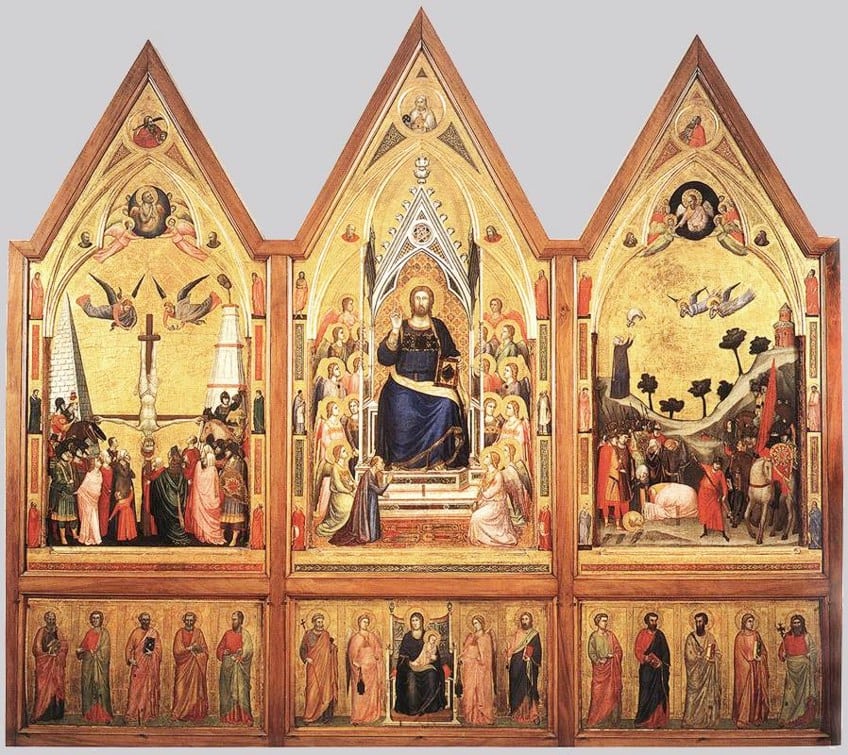 Stefaneschi Triptych (front) (c. 1330) past Giotto di Bondone;Giotto, Public domain, via Wikimedia Commons
Stefaneschi Triptych (front) (c. 1330) past Giotto di Bondone;Giotto, Public domain, via Wikimedia Commons
Late Period
Robert of Anjou, King of Naples, called Giotto to his courtroom in 1328. The Bardi household, for whom he had lately produced a series of murals for the household chapel in the church building of St. Croce, may have suggested him to Robert of Anjou. Meanwhile, in Naples, Giotto became a courtroom creative person, giving up the more unsafe nomadic lifestyle that had defined his work thus far.
He was paid a wage and a stipend for supplies and services, and in 1330, Robert of Anjou referred to him equally "familiaris," which meant that he had joined the purple household.
Regrettably, very few of his artworks from this time period have survived. A portion of a fresco depicting Christ's Lamentation in the church of Santa Chiara shows his stamp, and so does the ensemble of Illustrious Men that grace the windows of Castel Nuovo's Santa Barbara Chapel, simply academics commonly assign both works to Giotto'southward students.
 No. 36 Scenes from the Life of Christ: 20. Lamentation (The Mourning of Christ) (between 1304 and 1306) by Giotto di Bondone;Giotto, Public domain, via Wikimedia Commons
No. 36 Scenes from the Life of Christ: 20. Lamentation (The Mourning of Christ) (between 1304 and 1306) by Giotto di Bondone;Giotto, Public domain, via Wikimedia Commons
Shortly after his contempo stay in Naples, Giotto spent a brief period in the city of Bologna, where he completed a Polyptych for the church building of Santa Maria Degli Angeli and, it is thought, a long-lost ornamentation for Cardinal Legate's Chapel in the castle. Giotto returned to Florence again in 1334. Giotto had become acquainted with Sacchetti and Boccaccio in his later years, and he had also been portrayed in their stories. Sacchetti related an instance in which a layman requested Giotto to create his glaze of artillery on a shield; Giotto rather portrayed the shield "armed to the teeth," replete with a sword, spear, knife, and conform of armor.
He was charged after advising someone to "become into civilization for a while before y'all speak about weaponry like y'all're the Knuckles of Bavaria." Giotto filed a counterclaim and was granted two florins.
He directed the creation of fine art for the erection of Florence's cathedral, and his own add-on was a bell tower plan (although only the lower part of the belfry was eventually synthetic to his designs). The new church, which began construction at the end of the 13th century, would non be finished for some other 200 years. Post-obit his passing on the eighth of January, 1337, Giotto was plainly laid in the Santa Reparata at the expense of the city as a reflection of the reverence with which he was held. Giotto was buried in the Cathedral of Florence, on the left side of the entrance, and his burial is marked by a white marble plaque, according to Vasari. According to diverse stories, he was cached at the Church of Santa Reparata.
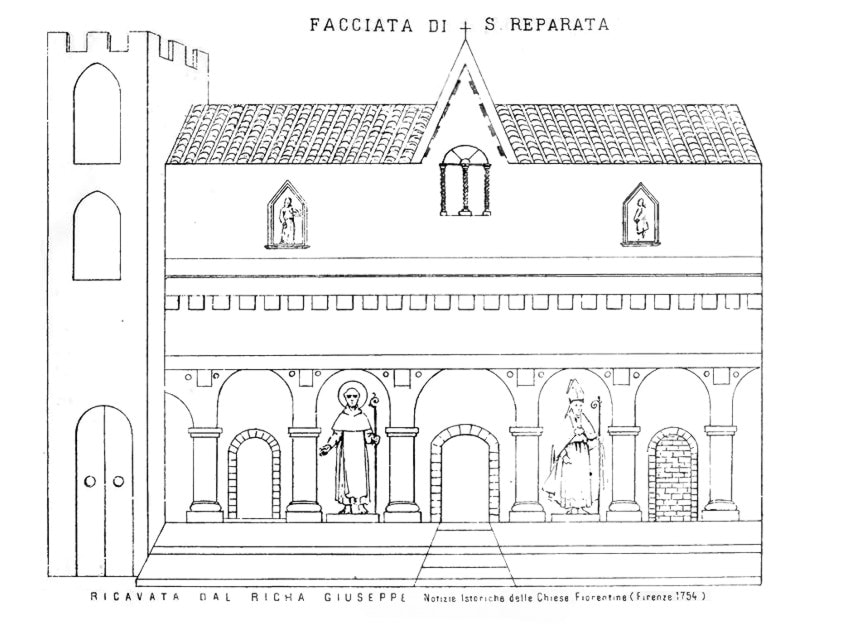 A drawing of the f acade of the Santa Reparata in Florence;Giaccai, CC By-SA four.0, via Wikimedia Commons
A drawing of the f acade of the Santa Reparata in Florence;Giaccai, CC By-SA four.0, via Wikimedia Commons
The somewhat contradictory traditions are resolved past the knowledge that the remains of Santa Reparata lay precisely below the Cathedral, and the church was still used in the early 14th century when the cathedral was being congenital.
During a 1970s excavation, bones were uncovered below the pavement of Santa Reparata, nearly the position mentioned past Vasari but unidentified on either level.
In 2000, anthropologist Francesco Mallegni and a group of specialists conducted a forensic analysis of the basic, which revealed some proof which seemed to verify that they were that of an creative person – especially the variety of substances, such every bit arsenic and pb, both typically found in paint, which the bones had soaked upwardly. The bones belonged to an extremely brusque individual, just over four anxiety in height, who may have had built dwarfism.
The Art Manner and Legacy of Giotto di Bondone
Giotto had a huge impact on the formation of the Italian Renaissance and, as a result, on virtually of the development of European art. Giotto's expansions of visual infinite and a desire for an unparalleled degree of authenticity would influence the early on masterminds of the Renaissance in Florence, and he was recognized as a master in his own fourth dimension by poets and intellectuals such as Dante and Boccaccio.
His bear upon may exist observed especially in the sculptural revolution started by personalities such every bit Donatello and Lorenzo Ghiberti in the first ten years of the 1400s, while his artistic legacy tin too be seen in the works of the young Masaccio ahead of 1420.
Giotto's influence stems generally from his early forays into Renaissance Humanism, a torso of philosophy that would be disquisitional to the growth of Renaissance art. Humanism entailed going to antiquity for noesis and visual skills. This may be observed in Giotto's piece of work via his focus on conveying man emotions, his depiction of the human figure, and his ability to bridge the gap betwixt biblical figures and human viewers. Giotto'south business organization in design, proportion, perspective, and even engineering exemplifies his Humanism.
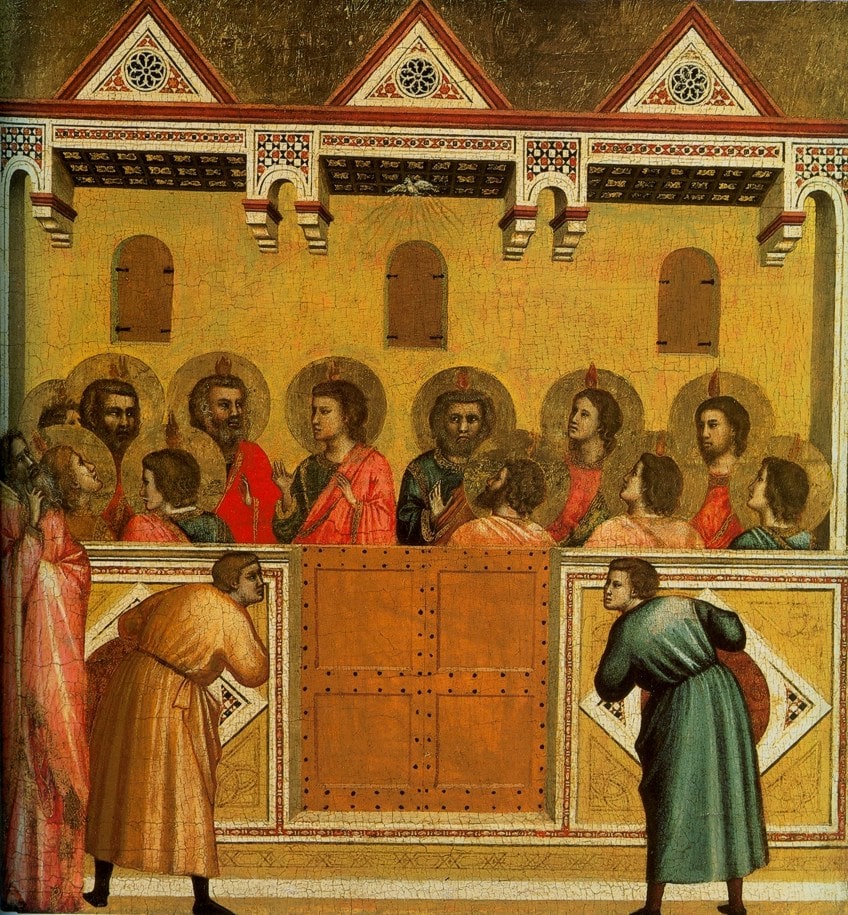 Pentecost (betwixt c. 1310 and c. 1318) past Giotto di Bondone; Giotto and workshop, Public domain, via Wikimedia Commons
Pentecost (betwixt c. 1310 and c. 1318) past Giotto di Bondone; Giotto and workshop, Public domain, via Wikimedia Commons
These were too of import parts of subsequent advances in Renaissance humanist thinking and art when humans became vital to creative attempt and the realistic representation of people and feeling became paramount. It is worth noting that there was a big gap between Giotto'southward early revolutionary work almost 1300 and the art revolution that occurred roughly a century later. This is almost probable due to the epidemic and economic depression that occurred between Giotto's demise and the beginning of the 15th century.
The plague pandemic of 1348 killed a big number of the residents of Florence, every bit well as places such as Siena, which had a thriving creative movement and style of its own up to this moment, but from which information technology never rebounded. Giotto'south achievements could not be completely appreciated and expanded upon until the comparative stability and affluence of Florence in the early on 1400s.
Afterwards painters acknowledged Giotto's impact, and his work rekindled attending among modernists operating in the early half of the twentieth century, including individuals such as Roger Fry and Henry Moore. Giotto is recognized as being among the get-go prominent artists from Italy, instilled in medieval art techniques a new feeling of humanism and expressiveness.
Modern painters began to run across "flat" Christian artworks every bit soulless and totally devoid of emotion equally a result of his influence. Through his care and attention, Giotto'southward "new realism" accentuated its humanity.
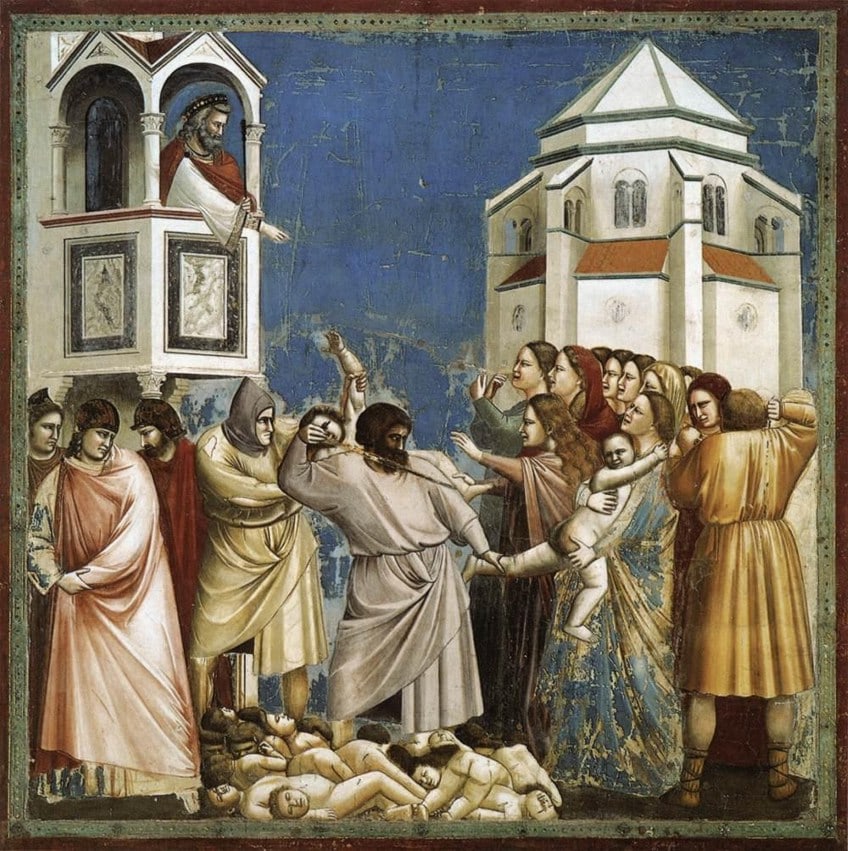 No. 21 Scenes from the Life of Christ: v. Massacre of the Innocents (between 1304 and 1306) by Giotto di Bondone; Giotto, Public domain, via Wikimedia Commons
No. 21 Scenes from the Life of Christ: v. Massacre of the Innocents (between 1304 and 1306) by Giotto di Bondone; Giotto, Public domain, via Wikimedia Commons
His three-dimensional figures were formed with gestures and movements, besides as precise clothes and furniture items. Notwithstanding their commitment to Christ, his humanistic pictures are central to his narrative. Giotto di Bondone was regarded as a highly renowned creative person during his lifetime. This was partly due to the great Italian poet Dante, who labeled him the virtually notable Italian artist, raising him in a higher place even Cimabue (originally Giotto's principal), who had previously been recognized as the most outstanding genius of 14th-century painting in Italian republic.
Giotto was too a well-known builder.
He worked equally a master builder on the Opera del Duomo in Florence, erecting the beginning stage of the Gothic (intended as much for aesthetic as utility) Bong Tower, which was called after him – Giotto's Bong Tower. The tower is unremarkably regarded as Italy's most magnificent campanile. Giotto di Bondone's art style was influenced by Arnolfo di Cambio'south strong and classicizing sculpture.
 Giotto'southward bong tower, situated next to the Santa Maria del Fiore church in Florence, Italy;Giovanni Dall'Orto, Attribution, via Wikimedia Eatables
Giotto'southward bong tower, situated next to the Santa Maria del Fiore church in Florence, Italy;Giovanni Dall'Orto, Attribution, via Wikimedia Eatables
Giotto's figures, dissimilar those of Cimabue and Duccio, are neither stylized nor elongated, and they do not attach to Byzantine models. They are substantially iii-dimensional, with shut-observed features and motions, and are dressed in fabrics that hang organically and have shape and weight rather than flowing structured draperies. He likewise experimented with foreshortening and having figures facing inward, with their backs to the observer, to create the feeling of spaciousness.
The people inhabit compacted surroundings with realistic aspects, frequently employing forced perspective tactics to simulate phase sets.
This resemblance is heightened by Giotto'south meticulous placement of the characters in such a manner that the observer seems to have a specific location and even involvement in several of the scenes. This is particularly axiomatic in the placement of the characters in Lamentation (1306) and the Mocking of Christ (1306), in which the composition invites the observer to become a blasphemer in one and a mourner in the other.
 No. 33 Scenes from the Life of Christ: 17. Flagellation (or The Mocking of Christ) (betwixt 1303 and 1306) by Giotto di Bondone; Giotto, Public domain, via Wikimedia Commons
No. 33 Scenes from the Life of Christ: 17. Flagellation (or The Mocking of Christ) (betwixt 1303 and 1306) by Giotto di Bondone; Giotto, Public domain, via Wikimedia Commons
Giotto'due south Renaissance depiction of emotions and facial expressions sets his work autonomously from those of his peers. When the shamed Joachim returns to the hill, the two youthful shepherds commutation sidelong glances. In the Massacre of the Innocents (1305), a soldier takes a wailing infant from its mother, his head bowed into his shoulders and an expression of humiliation on his confront. As they go to Arab republic of egypt, the people effectually them talk almost Mary and Joseph.
"He depicted the Madonna and the Christ and St Joseph, certain, by all means, just primarily Mother, Male parent, and Baby," wrote the English critic John Ruskin of Giotto's realism.
The Admiration of the Magi (1305), wherein a falling star-like Star of Bethlehem shoots through the sky, is i of the serial' most famous stories. Giotto is supposed to accept been influenced past Halley'south comet's 1301 advent, which resulted in the nickname Giotto existence assigned to a 1986 probe to the comet.
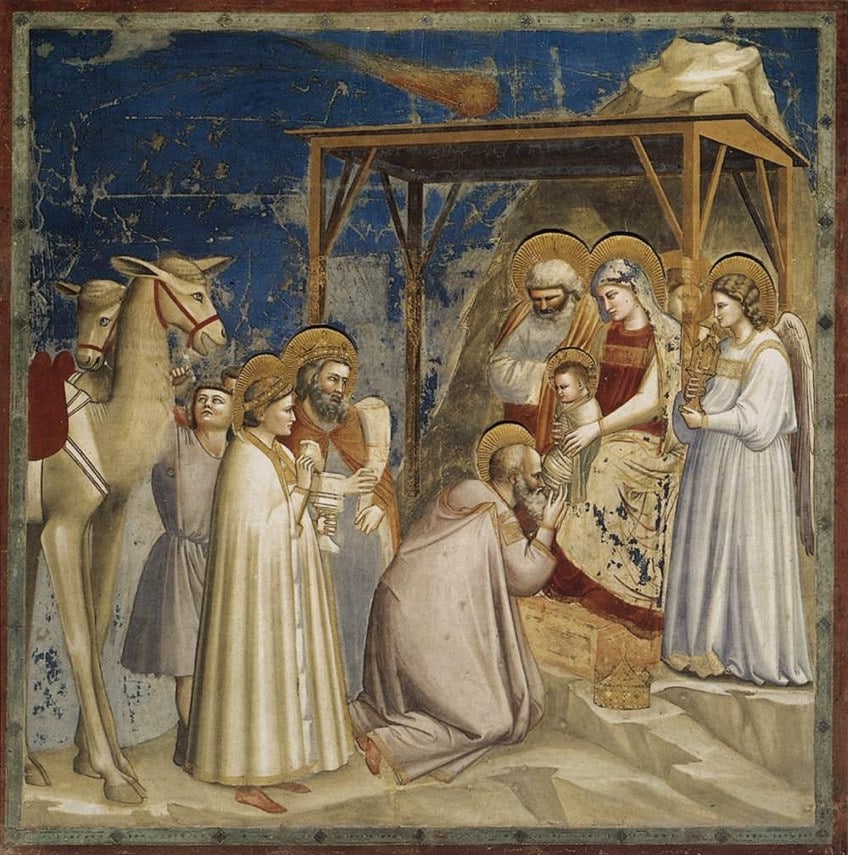 No. 18 Scenes from the Life of Christ: 2. Admiration of the Magi (between 1304 and 1306) by Giotto di Bondone;Giotto, Public domain, via Wikimedia Commons
No. 18 Scenes from the Life of Christ: 2. Admiration of the Magi (between 1304 and 1306) by Giotto di Bondone;Giotto, Public domain, via Wikimedia Commons
Giotto's About Influential Piece of work
Around 1305, Giotto completed his most meaning work, the interior frescoes of Padua's Scrovegni Chapel, which was designated a UNESCO Globe Heritage site in 2021, along with other 14th-century fresco cycles in other structures across the city center. Enrico degli Scrovegni ordered the chapel to be used for family prayer, burying, and as the scene for an annual mystery play.
The decoration's subject is Conservancy, with a focus on the Virgin Mary, equally the church is consecrated to the Annunciation and the Virgin of Clemency.
The Last Judgment (1306) dominates the west wall, as was usual in medieval Italian church décor. The Announcement is shown by contrasting artworks of the Virgin Mary and the angel Gabriel on either side of the chancel. The paintings, however, are more than simply depictions of well-known passages, and academics have discovered several sources for Giotto'due south interpretations of religious stories. Hither are a few more famous examples of Giotto di Bondone'due south art:
- Adoration of the Magi (1305)
- Lamentation (1306)
- Kiss of Judas (1306)
- The Terminal Judgment (1306)
- Pentecost (1306)
- Announcement (1306)
- Resurrection (1306)
- Madonna and Kid (c. 1320-1330)
 Madonna and Child (c. 1320-1330) by Giotto di Bondone;Giotto, Public domain, via Wikimedia Commons
Madonna and Child (c. 1320-1330) by Giotto di Bondone;Giotto, Public domain, via Wikimedia Commons
Recommended Reading
Who was Giotto and why was he famous? We accept tried to encompass all these questions, but perhaps you would like to notice even more about the artist in a Giotto di Bondone biography and fine art. Therefore, we have compiled a list of recommended books that will requite you even deeper insight into the life of the painter Giotto di Bondone.
Giotto and His Publics (2011) by Julian Gardner
This in-depth examination of iii Giotto works and the patrons who ordered them goes much across the stereotypes of Giotto the creative person as the founder of Western painting. It follows the relationships among Franciscan friars and wealthy financiers, shedding light on the intricate coaction between mercantile riches and poverty imagery. Political disharmonize and theological schism slashed fourteenth-century Italian republic. Giotto'due south assignments are interpreted within the context of this societal upheaval. They represented his sponsors' requests, the Franciscan Order's regulations, and the painter'due south restless imaginative creativity.
These paintings were created during a 20-year period in which the friars were split internally and the Order was presented with a major shift in papal policy regarding its distinguishing vow of poverty. The Society had gained considerable money and constructed improvident churches, repelling many Franciscans and earning the antagonism of other Orders in the process. Many aspects in Giotto's paintings were incorporated to appease clients, reinterpret the persona of Francis, and glorify the ruling faction within the Franciscan fraternity, incorporating links to St. Peter, Florentine economics, and church structure.

View on Amazon
Giotto and His Works in Padua (2016) by John Ruskin
Scholars chose this work as culturally meaning, and information technology is now office of the intellectual foundation of guild as we recognize it. This work was copied from the original item and is equally accurate as possible to the original. Every bit a issue, yous volition observe the original copyright citations, library stamps – as the majority of these publications accept been stored in our about significant libraries throughout the earth – and other transcriptions in the work. Scholars feel, and we concord, that this textile is significant enough to be saved, duplicated, and widely distributed to the public. We capeesh your help in the preservation attempt, and we thank you for your contribution to keeping this information alive and relevant.

- A set of reflections on Giotto's Arena Chapel fresco bicycle
- A new edition that presents each work in bright color photography
- Ekphrastic writing by John Ruskin allows readers to experience art
View on Amazon
Delphi Complete Works of Giotto (2016) past Peter Russel
Giotto di Bondone was the prominent Artist of the 14th century, whose groundbreaking paintings would bring on to the discoveries and marvels of the High Renaissance. He is regarded as the founder of European art and the first of great Italian painters. Delphi's Masters of Art Series introduces the world'south premier digital e-Art books, enabling consumers to thoroughly examine the works of renowned painters. This collection beautifully exhibits Giotto's complete works, with succinct introductions, hundreds of loftier-quality photographs, and the typical Delphi supplementary content.

- The globe's first digital e-Fine art book on Giotto's consummate works
- With hundreds of Giotto's paintings and rare works in stunning color
- Features highlights, bonus biographies, and enlarged "detail" images
View on Amazon
Giotto the creative person is recognized as one of the about significant painters in Western art history. Giotto'due south Renaissance style heralded a new era in the arts by combining spiritual antiquity with the embryonic thought of Renaissance Humanism, predating many of the fascinations and difficulties of the Italian High Renaissance by 100 years. Furthermore, many historians believe that the painter Giotto had an unequaled affect on European art until Michelangelo resumed his role 200 years later.
Frequently Asked Questions
Who Was Giotto di Bondone?
Giotto di Bondone was an artist from Italy. Giotto was perhaps the near supreme creative person in his day, drawing all his models and their poses true to nature, and his ability and quality were well acknowledged. Giotto was credited with ushering in the magnificent painting and sculpture as we know information technology at present, establishing the method of cartoon precisely from life, which had been ignored for more than 2 hundred years.
What Is Giotto Famous For?
Giotto de Bondone was a notable 14th-century artist whose pioneering paintings paved the mode for the High Renaissance'due south discoveries and miracles. He is oftentimes considered the father of painting in Europe and the very beginning of the not bad painters to come from Italia. The assignments of Giotto are best understood from the perspective of this socio-economical upheaval. Giotto'south most important work, the interior paintings of Padua's Scrovegni Chapel, was finished about 1305 and was named a UNESCO World Heritage site in 2021.
Source: https://artincontext.org/giotto-di-bondone/
0 Response to "When Did Giotto Di Bondone Make His First Art Piece"
Post a Comment